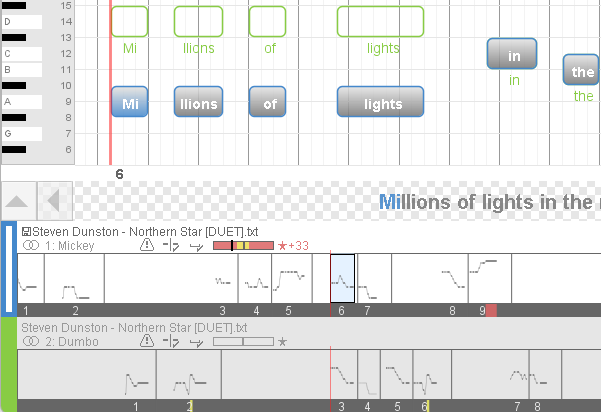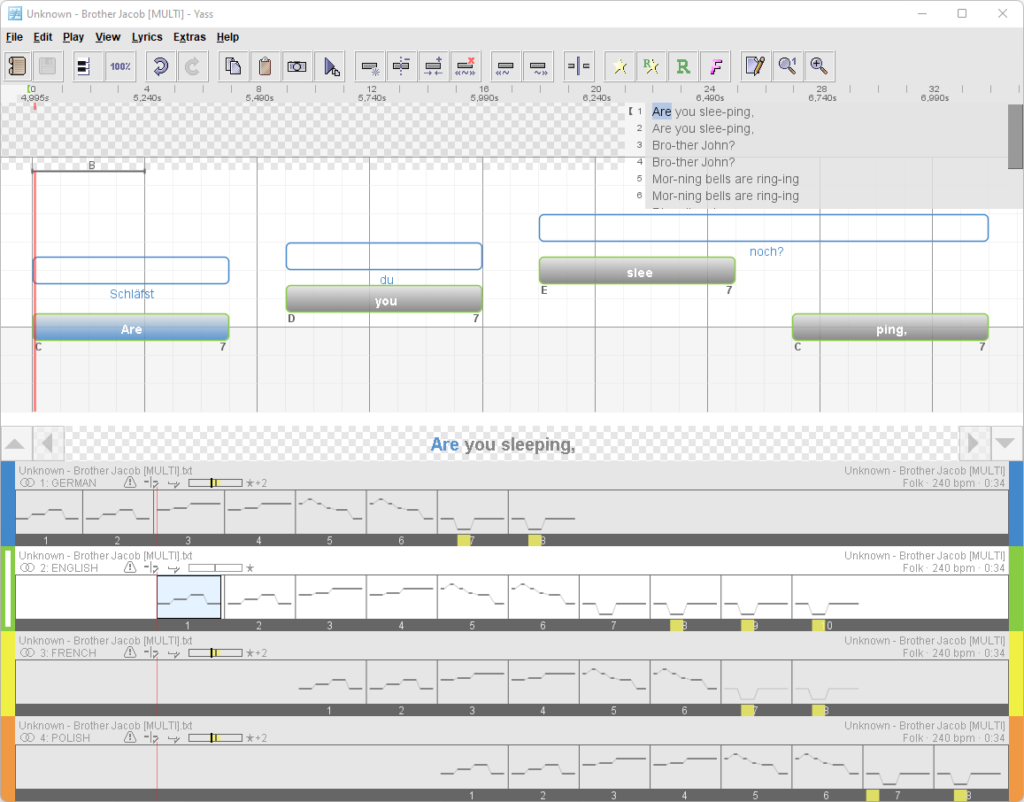Tracks
A karaoke file can contain data for two singers (duet).
Icon: ⚭ 2
The Yass editor internally splits singer data into two tracks. Both tracks are shown on the timeline; the active track is editable. In the track overview you can activate a track, jump to any track’s page, and review track errors.

To create a duet, start with a single track and add a second track later:
- Menu > File > Save Track as… > Choose location for the new track
- Menu > File > Open Track… is not needed, because the new track is already opened
- Menu > File > Merge All as… > Choose location for duet file
- Menu > File > Rename Track… > Choose the singer name for the new track
Then erase lines in track 1 that are sung only by the second singer, and vice versa:
- Menu > Edit > Select page (Ctrl+A or double-click)
- Menu > Edit > Erase (Ctrl+Del)
Two singers normally differ in timing, pitches, and lyrics. In the karaoke file, the corresponding singer data is marked with “P 1” and “P 2”.
If singers share the same notes/text, lines are greyed out in the track overview. Some karaoke editors mark such notes with “P 3” and assign them to both players (3 = 1 + 2). Yass can handle that, however it never uses “P 3” for saving data. Instead, Yass stores singers’ data sequentially, starting with all notes for the first singer, then all notes for the second singer.
Example karaoke data for a duet:
#TITLE: Northern Star#ARTIST: Steven Dunston
#DUETSINGERP1: Mickey
#DUETSINGERP2: Dumbo
P 1
...Mickey's notes...
P 2
...Dumbo's notes...
EMultitracks
By adding more tracks you can create trios and quartets. Please note: you won’t be able to sing them, as no karaoke player supports them – for now.

In the karaoke file, the third and forth singers are marked with “P 4” and “P 8”. The reason behind is that “P 3” is already reserved (see above) and the P-number must actually be read bitwise as singer mask.
Example karaoke data for a quartet (view full text or download package):
#TITLE: Brother Jacob
#ARTIST: Unknown
#DUETSINGERP1: German
#DUETSINGERP2: English
#DUETSINGERP3: French
#DUETSINGERP4: Polish
P 1
...German notes...
P 2
...English notes...
P 4
...French notes...
P 8
...Polish notes...
EThe singer mask provides all combinations of sharing lines between two, three, or four singers. Yass can read all combinations, but uses only “P 1”, “P 2”, “P 4”, “P 8” when writing singers’ data.
Singer Mask
4 | 3 | 2 | 1
4 | 3 | 2 | 1
4 | 3 | 2 | 1
4 | 3 | 2 | 1
4 | 3 | 2 | 1
4 | 3 | 2 | 1
4 | 3 | 2 | 1
4 | 3 | 2 | 1
…
4 | 3 | 2 | 1
Singer
1
2
1+2
3
1+3
2+3
1+2+3
4
…
1+2+3+4
Markup in File
P 1
P 2
P 3
P 4
P 5
P 6
P 7
P 8
…
P 15
Comparing Song Versions
You can use tracks to compare different karaoke files for the same song. Just select both in the song library and open the editor. Both versions are shown simultanously and you can quickly review the differences.
Next page: Creating Songs